Last Updated on December 29, 2024 by Kittredge Cherry
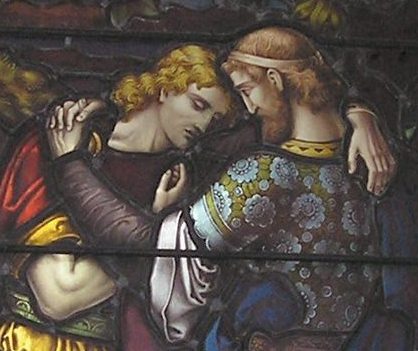
Love between men is celebrated in the Bible with the story of David and Jonathan. “Your love to me was wonderful, surpassing the love of women,” David said in his famous a lament for Jonathan. David’s feast day is Dec. 29.
Their relationship inspires LGBTQ people and affirms that same-sex couples are blessed by God. New and historical artists, writers and musicians illustrate the same-sex love between Jonathan and David here.
Selections from the story of David and Jonathan was read in many churches on June 23 and June 30, 2024, as part of the three-year lectionary cycle. The verses about Jonathan and David’s covenant (1 Sam 18:1-6) are omitted. Not every church is ready to hear, “And Jonathan made a covenant with David because he loved him as himself. 4 Jonathan took off the robe he was wearing and gave it to David, along with his tunic, and even his sword, his bow and his belt.” The suppression of Biblical same-sex love goes back much further. These lines are also missing from the Septuagint, the earliest extant Greek translation of the Hebrew scriptures.
The Bible presents the deep love between two men without any condemnation, making them some of history’s first queer religious role models. The modern idea of sexual orientation didn’t exist in Biblical times, but the powerful love story of David and Jonathan in 1 and 2 Samuel suggests that God supports same-sex couples. It’s impossible to know whether David and Jonathan expressed their love sexually. Some consider David to be bisexual, since the Hebrew scriptures also recount how he committed adultery with Bathsheba and later made her one of his eight wives. Jonathan also had a wife.

The “David loved Jonathan” billboard was part of the WouldJesusDiscriminte.org project sponsored by Metropolitan Community Churches. It states boldly, “David loved Jonathan more than women. II Samuel 1:26.” For more info, see the previous post, “Billboards show gay-friendly Jesus.”
There is no doubt that many people today do honor David and Jonathan as gay saints. Contemporary LGBTQ Christians point to Jonathan and David to counteract conservatives who claim that the Bible condemns homosexuality. Wedding ceremonies are absent from the Bible, so the same-sex covenants between David and Jonathan or Ruth and Naomi provide the best Biblical models for marriage vows, even for heterosexual couples.
Why David and Jonathan are popular
This article is the all-time most popular post here at Q Spirit. People like David and Jonathan because they can relate to their humanity, with complex contradictions and a mix of virtues and flaws. Of course, their selfless and enduring love is inspiring — and all the more poignant because it ends with Jonathan’s untimely death. The pair also has a wide appeal because they are in the Bible and lived thousands of years ago. Christians and Jews both see David as the ancestor of the Messiah, and he is honored in Islam too. The queer aspect adds a layer of interest to an already ambiguous, multi-dimensional story. David’s bisexuality may also help more people connect with him.
David and Jonathan: The shepherd and the prince.
David and Jonathan are usually mentioned together in the LGBTQ community, but David is much more famous than Jonathan in the mainstream world. In fact, he’s one of the most popular people in the Bible. His name means “beloved,” and he is still well-loved today.
Many people can relate to David because he is such a versatile, well-rounded hero. He grew from a youthful underdog who defeated a giant enemy to become a powerful military leader, Israel’s greatest king, a passionate poet, a singer-songwriter who played the harp, and a man of profound faith. He is simply, as the Bible says, “a man after God’s own heart” (1 Samuel 13:14). The gospel genealogies list David as an ancestor of Jesus. He is credited with composing many of the psalms in the Bible. They dig to the depths of human emotion, expressing everything from joy to rage, fear and despair, always in dialogue with the divine. Written in Hebrew, his hymns of praise are foundational to western culture. “Rainbow Psalms in 30 Days” is a version of the psalms adapted by Stephen Joseph Wolf with LGBTQ readers specifically in mind. David’s spiritual energy was matched by worldly achievements. The multi-faceted leader united all the tribes of Israel, founding a royal dynasty that ruled for 400 years. He established the capital in Jerusalem and brought the Ark of the Covenant there. But he also sinned in a big way, committing adultery and murder. His moral failings actually make him more alluring to some because his life proves that God loves and uses imperfect people.

Jonathan and David embrace in a manuscript illustration, circa 1300. La Somme le roy (Wikipedia)
David was also physically attractive. The Bible describes him as “ruddy, with beautiful eyes and a handsome appearance” (1 Samuel 16:12). He was rated the third most handsome man in the Bible in one poll. Artists have long portrayed David as the embodiment of idealized male beauty. Famous nude statues of David were sculpted by Renaissance artists Michelangelo and Donatello. Gay commentators detect and admire queer undertones in both of them, especially Donatello’s version of a seductive, androgynous youth. Scholar Sage Ferraro Doughty argues that David’s dancing and style of dress were “profoundly genderqueer” in the 2023 Ph.D. thesis “The sanctification of the queer body: Genderfluidity as an expression of holiness in 2 Samuel 6” at the University of Birmingham, United Kingdom.
In some ways David and Jonathan were opposites, but they also had much in common. Both were courageous warriors with strong faith in God. Jonathan was the oldest son of Israel’s first king, Saul, and his wife Ahinoam, so he was first in line to inherit the crown. David was the last of seven or eight sons born to a farmer, Jesse. Before meeting Jonathan, David tended sheep for his father. His mother is not named in the Bible, but Jewish tradition identifies her as Nitzevet. His great-grandparents were Boaz and Ruth — the same Ruth whose legendary love for Naomi makes her a queer saint. The high-born prince Jonathan and the upstart shepherd David should have been rivals for the throne, but instead they fell in love. Jonathan gave up his own birthright as the future king, vowing to support David as king instead.
David and Jonathan in scripture
The Bible chronicles the ups and downs of David and Jonathan’s relationship over a 15-year period, including tears and kisses. King Saul is jealous of David and keeps trying to kill him, while his son Jonathan rescues his friend in various ways. David and Jonathan became so close that it looked like someday they would rule Israel together. But that day never came because Jonathan was killed in battle. David mourned deeply for him with a famous lament.
David and Jonathan actually made two separate but intertwined covenants: when they first met (1 Samuel 18:3) and again later (1 Samuel 20:16-17) when Jonathan warns David before their tearful goodbye. Both covenants share the same core theme of love and mutual support.
The Biblical narrative about David is unwieldy, repetitive and long (the longest in the Hebrew scriptures) with many dramatic ups and downs. Bible scholars find evidence for his queerness primarily in his relationship with Jonathan, but they also discern tantalizing hints in other parts of his life, including his near-naked public dance before God in 2 Samuel 6:14-16, and his adoption of Jonathan’s adult son, Mephibosheth. Whole books have been written to decode the homoerotic nuances in the original text about David and Jonathan’s love story. To get the big picture, the drama can be broken down into a few key scenes.
First meeting and covenant (1 Samuel 17:57 – 18:4)
Tearful farewell and renewal of covenant (1 Samuel 20:1-42)
Final meeting and renewal of covenant (1 Samuel 23:16-18)
David’s lament over Jonathan (2 Samuel 1:17-27)
David and Jonathan’s most dramatic love scenes
First meeting and covenant (1 Samuel 17:57 – 18:4)
The two men meet right after the defining moment in David’s life: The young shepherd used a slingshot to kill the giant Philistine warrior Goliath. Their battle left such a big impression on western culture that “David and Goliath” has become an archetype for anytime an underdog faces a stronger opponent. David carries Goliath’s head to the king and meets his son Jonathan. Scholars estimate that David was about 18 years old at the time, while Jonathan was at least 10 years older.
Jonathan fell in love at first sight. As the Bible says, “The soul of Jonathan was knit with the soul of David, and Jonathan loved him as his own soul.” (1 Samuel 18:1). Their story gets more chapters in the Bible than any other human love story.
The two men bonded instantly and soon expressed their commitment by making a covenant with each other. The dramatic moment is described in 1 Samuel 18:3-4: “Then Jonathan made a covenant with David, because he loved him as his own soul. Jonathan stripped himself of the robe that he was wearing, and gave it to David, and his armor, and even his sword and his bow and his belt.”
Tearful farewell and renewal of covenant (1 Samuel 20:1-42)
As danger escalates, Jonathan and David renew their vows twice (1 Samuel 20:16-17 and 1 Samuel 23:16-18), expanding their covenant into the future to include their descendants. Jonathan makes an all-out pledge to David. His promise in 1 Samuel 20:4 is translated variously as “I will do the desires of your heart” or “Whatever you want me to do, I’ll do for you.”
Jonathan goes to meet David at a pile (or “ezel”) of stone on the day after the New Moon festival. His goal is to warn David that Saul intends to kill him. Knowing that David must flee for his life, they share kisses and tears before they part in 1 Samuel 20:41-42:
“Then they kissed each other and wept together—but David wept the most. Jonathan said to David, ‘“Go in peace, for we have sworn friendship with each other in the name of the Lord, saying, ‘The Lord is witness between you and me, and between your descendants and my descendants forever.’”
Final meeting and renewal of covenant (1 Samuel 23:16-18)
Jonathan seeks out David in the wilderness of Ziph at Horesh to encourage him. They renew and clarify their vows, enhancing the value and validity of their previous promises. Jonathan specifically commits to support David as king and serve as his and serve as his second in command. This is the last time that they see each other alive.
David’s lament over Jonathan (2 Samuel 1:17-27)
Jonathan is killed in a battle against the Philistines at Mount Gilboa, along with his father and brothers. David is devastated when he heard the news. He mourns with a lament that includes these lines:
I am distressed for you, my brother Jonathan;
You have been very pleasant to me;
Your love to me was wonderful,
Surpassing the love of women.
[New King James Version]
The phrase “surpassing the love of women” has caught the attention of many LGBTQ people. There are many translations of 2 Samuel 1:26, each one expressing how the love between Jonathan and David was “greater than,” “more wonderful than,” “deeper than” or otherwise “surpassing” heterosexual love.
The love between David and Jonathan follows a literary pattern dating back to “The Epic of Gilgamesh,” which may be the oldest written story on earth. Recorded around 2100 BC, the epic poem follows the adventures of Sumerian king and demigod Gilgamesh, including his love for the primitive man Enkidu and his intense lament when Enkidu dies. The parallels between the two stories are explored in the book “When Heroes Love: The Ambiguity of Eros in the Stories of Gilgamesh and David” by Susan Ackerman (Columbia University Press, 2005).
David and Jonathan still make an impact
David and Jonathan’s story continues to make an important impact on religion, culture and the arts. In addition to contemporary queer interpretations, David and Jonathan’s man-to-man love has been celebrated by historical theologians with a current LGBTQ following, such as Pavel Florensky, John of the Cross and Aelred of Rievaulx, John of the Cross and Pavel Florensky.
Russian Orthodox theologian Pavel Florensky also cites David and Jonathan as models of Christian friendship in his monumental 1914 book “The Pillar and the Ground of The Truth: An Essay in Orthodox Theodicy in Twelve Letters.” Sixteenth-century Spanish mystic John of the Cross is one of the many writers who used their same-sex love as a model for divine love. “The love Jonathan bore for David was so intimate that it knitted his soul to David’s. If the love of one man for another was that strong, what will be the tie caused through the soul’s love for God, the Bridegroom?” John of the Cross asked in “The Spiritual Canticle.” Aelred of Rievaulx, a 12-century English abbott encouraged friendships between monks, comparing them to the love between Jonathan and David or Jesus and his beloved disciple in his treatise “On Spiritual Friendship” (De Spirituali Amicita). The section on David and Jonathan concludes, “Here is a true and perfect friendship, solid and eternal… Assailed with abuse, it stands firm; beaten with insults, it does not bend. Go thou, and do likewise.”
New in 2024: Tender sketches of David and Jonathan’s love
Two sketches of dramatic moments in the love life of David and Jonathan were completed in 2024 by was sketched by Tobias Haller, an iconographer, author, composer, and retired vicar of Saint James Episcopal Church in the Bronx, still assisting at a parish in Baltimore, Maryland. Haller enjoys expanding the diversity of icons available by creating icons of LGBTQ people and other progressive holy figures as well as traditional saints.
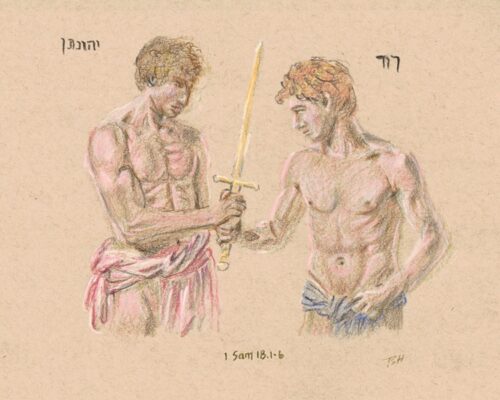
“Jonathan Makes a Covenant with David” by Tobias Haller
“Jonathan Makes a Covenant with David” shows Jonathan passing his sword to David after making the vow of love in 1 Samuel 18:1-6. Haller also explored the meanings of this passage in a sermon titled “Love and Envy.”
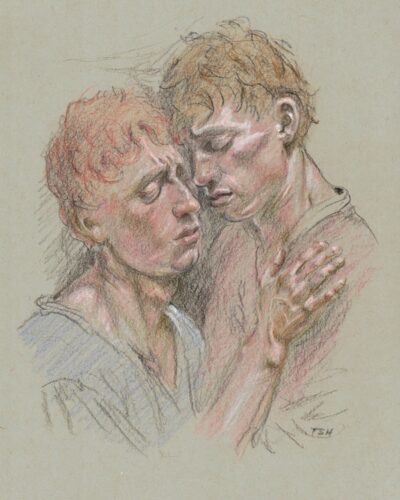
“The Parting of David and Jonathan” by Tobias Haller
“The Parting of David and Jonathan” was widely praised as “tender and beautiful” in comments when Haller first shared it on social media. It illustrates the farewell scene that begins with 1 Samuel 20:41: “David got up from the south side of the stone and bowed down before Jonathan three times, with his face to the ground. Then they kissed each other and wept together—but David wept the most.” His artwork appears frequently on Q Spirit.
David and Jonathan in literature
The love between the two men is also celebrated in literature, including the poem “The Meeting of David and Jonathan” by 19th-century English poet John Addington Symonds. He is known as an early advocate of male love (homosexuality) and wrote many poems inspired by his own homosexual affairs. In “The Meeting of David and Jonathan” he writes:
There by an ancient holm-oak huge and tough,
Clasping the firm rock with gnarled roots and rough,
He stayed their steps; and in his arms of strength
Took David, and for sore love found at length
Solace in speech, and pressure, and the breath
Wherewith the mouth of yearning winnoweth
Hearts overcharged for utterance. In that kiss
Soul unto soul was knit and bliss to bliss.
The full poem appears in “Many Moods: A Volume of Verse” by Symonds.
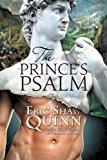 Epic same-sex love between David and Jonathan is fleshed out in the 2016 historical novel “The Prince’s Psalm” by Eric Shaw Quinn, a New York Times-bestselling author. It is a perennial bestseller at Q Spirit. Beginning with young David slaying Goliath, the book shows how he won the heart of Prince Jonathan, heir to the throne of Israel. The star-crossed warrior-lovers face conflicts with King Saul and others as the Biblical story unfolds and David grows to become a king himself. The author uses artistry and restraint to present sex scenes between David and Jonathan (and each man with his own wife). With meticulous research and dynamic storytelling skills, he brings alive the dramatic same-sex love story at the core of religious tradition. The author is a celebrity ghostwriter who wrote novelizations of the TV series “Queer as Folk.”
Epic same-sex love between David and Jonathan is fleshed out in the 2016 historical novel “The Prince’s Psalm” by Eric Shaw Quinn, a New York Times-bestselling author. It is a perennial bestseller at Q Spirit. Beginning with young David slaying Goliath, the book shows how he won the heart of Prince Jonathan, heir to the throne of Israel. The star-crossed warrior-lovers face conflicts with King Saul and others as the Biblical story unfolds and David grows to become a king himself. The author uses artistry and restraint to present sex scenes between David and Jonathan (and each man with his own wife). With meticulous research and dynamic storytelling skills, he brings alive the dramatic same-sex love story at the core of religious tradition. The author is a celebrity ghostwriter who wrote novelizations of the TV series “Queer as Folk.”
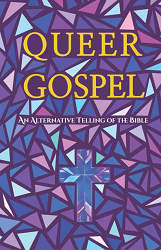 “Queer Gospel: An Alternative Telling Of The Bible” by Riley Alerton includes a version of the story of David and Jonathan where Jonathan is killed by a homophobic priest. His lament becomes, “My partner Johnathon, whose soul was knit into mine as one, has been slain in the name of God by terrible homophobes in Heteros. His love for me was sublime, finer than the love of women.” The book appears on Q Spirit’s list of the top LGBTQ Christian books of 2022.
“Queer Gospel: An Alternative Telling Of The Bible” by Riley Alerton includes a version of the story of David and Jonathan where Jonathan is killed by a homophobic priest. His lament becomes, “My partner Johnathon, whose soul was knit into mine as one, has been slain in the name of God by terrible homophobes in Heteros. His love for me was sublime, finer than the love of women.” The book appears on Q Spirit’s list of the top LGBTQ Christian books of 2022.
 The timeless story of David and Jonathan is re-imagined through a queer lens in the 1990s Midwest with “That’s Me in the Corner: A Royally Tragic Tale of Queer Love of Biblical Proportions” by Jeff Crim. It was independently published in 2023. Based in Tennessee, the author is an ordained minister in the Evangelical Lutheran Church.
The timeless story of David and Jonathan is re-imagined through a queer lens in the 1990s Midwest with “That’s Me in the Corner: A Royally Tragic Tale of Queer Love of Biblical Proportions” by Jeff Crim. It was independently published in 2023. Based in Tennessee, the author is an ordained minister in the Evangelical Lutheran Church.
Gay-positive Bible scholars have written extensively about the relationship between David and Jonathan. The classic book on the subject is “Jonathan Loved David: Homosexuality in Biblical Times,” published in 1978. It was written by Thomas Horner, an Episcopal priest with a doctorate in religion from Columbia University and Union Theological Seminary.
David and Jonathan in art
Artists have long been attracted to the idealized male beauty of David. Famous nude statues of David were sculpted by Renaissance artists Michelangelo and Donatello. Gay commentators detect queer undertones in both of them, especially Donatello’s version of a seductive, androgynous youth.
The love between the two men is honored in a golden icon by Brother Robert Lentz. Unlike most images of Jonathan and David, the Lentz icon shows Christ above blessing their relationship. It is one of 10 Lentz icons that have sparked controversy since in 2005 when conservative Roman Catholic leaders accused Lentz of glorifying sin and creating propaganda for a progressive sociopolitical agenda with these “Images That Challenge.”
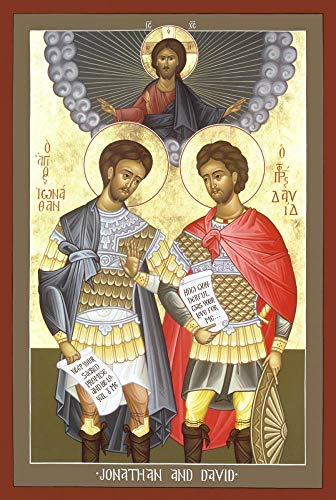
Prints of “Jonathan and David” by Robert Lentz are available through Amazon and TrinityStores.com.
Artists throughout the ages have illustrated the the drama and same-sex passion of their story, beginning with the moment that David and Jonathan met. A beautiful romantic version of their first meeting appears on their stained-glass window at St. Mark’s Portobello, a Scottish Episcopal church in Edinburgh. The inscription states, “The soul of Jonathan was knit with the soul of David” (1 Samuel 18:1).
Created in 1882, the window has a dedication at the bottom: “In loving memory of George Frederick Paterson of Castle Huntly who died at Portobello, 30th Sept. 1890, aged 33.” All that is known about Paterson is that he was in the army and unmarried. The window was paid for by “a friend.”
Another stained-glass window of David and Jonathan is located at Calvary Presbyterian Church in Indiana, Pennsylvania. It was created in the Tiffany style by Robert L. Dodge in 1906. The window is dedicated to the memory of John Sutton and A.W. Wilson, founders of Indiana University of Pennsylvania. It can be seen online at Stained Glass Resources Inc., which restored the window in 2000.
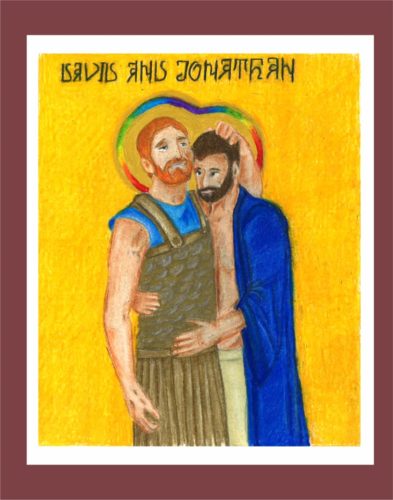
“David and Jonathan” by Katy Miles-Wallace. Available as prints and more at the Queerly Christian Zazzle shop.
David and Jonathan share a rainbow halo in an icon created in 2017 by queer Lutheran artist and seminarian Katy Miles-Wallace as part of her “Queer Saints” series. It appears at the top of this post. The series presents traditional saints with queer qualities and heroes of the LGBTQ community.
The icons are rooted in queer theology and in Miles-Wallace’s eclectic faith journey that began at a Baptist church in Texas and led to study at Pacific Lutheran Theological Seminary in Berkeley, California. She drew many of them on the altar of a seminary chapel. For more info, see the Q Spirit article “New icons of Queer Saints created by artist Katy Miles-Wallace.”
California artist Ryan Grant Long emphasizes the homoeroticism of the moment when Jonathan strips off his robe and wraps it around David with a kiss on the neck. For more about Long, see my previous post Artist paints history’s gay couples.
Artist Brandon Buehring imagined both men stripped bare in a private encounter between Jonathan and David in his “Legendary Love: A Queer History Project.” He uses pencil sketches and essays “to remind queer people and our allies of our sacred birthright as healers, educators, truth-tellers, spiritual leaders, warriors and artists.”
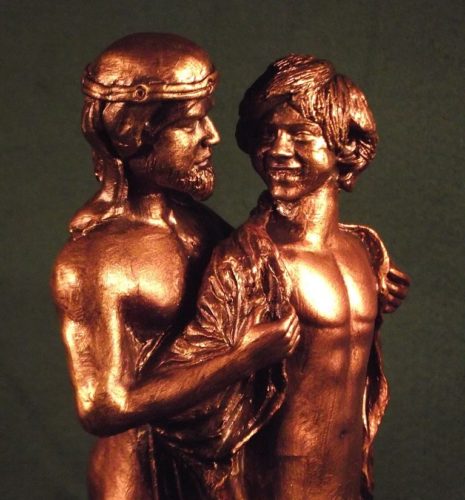
David and Jonathan sculpture by Malcolm Lidbury, 2016 (Wikipedia)
David and Jonathan are among the many historical male couples sculpted by British gay artist/activist Malcolm Lidbury. They were included in his Cornwall LGBT History and Gay Art Sculpture ‘Open Studio’ Exhibition for National LGBT History Month in 2016.
Lidbury portrays the embrace of David and Jonathan with full frontal nudity. The exhibit (and related video) also include Saint Sebastian, Oscar Wilde and many others. The figures appear to be solid bronze, but are actually a thin film of bronze paint over composite construction of wood, plastic, metal and such. These materials are a metaphor expressing the artist’s belief that laws protecting LGBTQ people appear strong but are actually a fragile veneer.
A more traditional view is presented by 16th-century Italian painter Cima da Conegliano. In both images David is still carrying the head of Goliath as he bonds with his new friend Jonathan, hinting at the union of violence and eroticism.
In contrast New Mexico artist Trudie Barreras shows the new friends both putting aside their armor to make a covenant with each other (left).
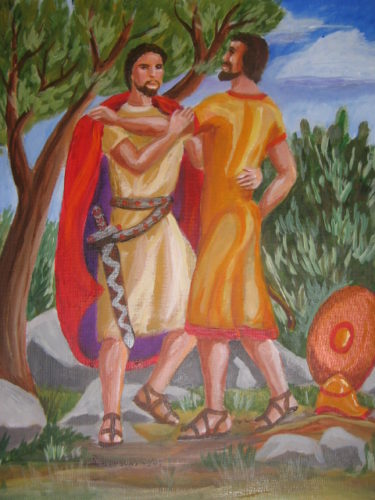
“Jonathan Made a Covenant with David” by Trudie Barreras, Collection of City of Light / First Metropolitan Community Church of Atlanta
An 18th-century German “friendship medal” (below) captures another highlight as Jonathan pledges to David, “I will do the desires of your heart” (“Ich will die thun was dein Herz begehrt”) from 1 Samuel 20:4.
Other artists focus on a dramatic moment that came later when Jonathan met David at a pile (or “ezel”) of stone to warn him that Saul intended to kill him. An 1860 woodcut by German artist Julius Schnorr von Carolsfeld illustrates that tearful farewell scene from 1 Samuel 20: 41-42:
“Then they kissed each other and wept together—but David wept the most. Jonathan said to David, “Go in peace, for we have sworn friendship with each other in the name of the Lord, saying, ‘The Lord is witness between you and me, and between your descendants and my descendants forever.’”

“David and Jonathan” woodcut for “Die Bibel in Bildern”, 1860, by Julius Schnorr von Carolsfeld (Wikimedia Commons)
A much more intimate, contemporary view of the parting kiss was drawn by Maddy Caless, a illustrator based in Norwich, United Kingdom. She captures the timeless moment when David and Jonathan kiss in I Samuel 20:41 by showing the Biblical pair looking much like gay men today.
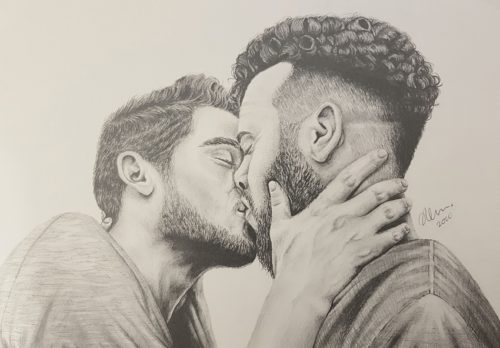
David and Jonathan kiss in a drawing by Maddy Caless.
Another version of the farewell scene was painted by American folk artist and Quaker minister Edward Hicks in 1847. In both paintings a boy can be seen carrying away their weapons. In the lower right Hicks places a scene of the Good Samaritan rescuing a downtrodden man. Interestingly, the Jonathan and David window at St. Mark’s Portobello is also paired with a window showing the Good Samaritan. Scholar Mitch Gould analyzes the painting for the Jesus in Love Blog in his article Biblical same-sex love found in “David and Jonathan” art by Edward Hicks.
Contemporary gay Israeli artist Adi Nes gives shocking clarity to David and Jonathan by using images of homoeroticism and homelessness to subvert stereotypes about people in the Bible. The triumph of David over Goliath is often used to symbolize Israel’s military victories over its enemies, but Nes chooses to depict David as a vulnerable youth with a crutch, leaning on another young man for love and support. Dirty and unkempt, they embrace beneath an industrial overpass covered by graffiti. They look battered, perhaps from a gay bashing. The tender moment suggests the scenes when “the soul of Jonathan was knit to the soul of David” or when “they kissed each other and wept together.” (For more about Adi Nes, see my previous post “Gay Israeli artist Adi Nes humanizes Bible stories. “
Musical “Beloved King” celebrates David and Jonathan
The love triangle between David, Jonathan — and Jonathan’s father Saul — sprang to life in the 2020 queer Bible musical “Beloved King.” The show brings out all the homoerotic nuances in the scriptures with a faithful adaptation and emotional intensity that stirs both heart and soul. The passionate gay love saga of plays out against a dizzying backdrop of war and witches.
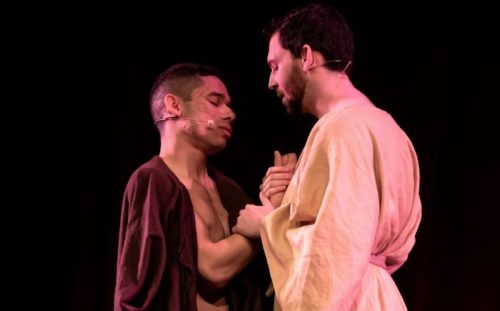
David (Felton Sparks at left) and Jonathan (Ben Freeman) meet for the first time in “Beloved King” (Photo by Jonathan Beckley.)
“Beloved King” was written by Jade Sylvan as one of the requirements for a master of divinity degree at Harvard Divinity School. Sylvan has won awards for writing in various media, including the New England Book Award for the 2013 novelized memoir “Kissing Oscar Wilde.”
The first run of “Beloved King” performances was sold out for March 2020 at Oberon Theater in Harvard Square, Cambridge. But the night before opening it had to be postponed indefinitely due to the surge in the COVID-19 pandemic. During the shutdown Sylvan occasionally makes the final dress-rehearsal video available through live-stream viewing parties.

The relationship between David and Jonathan heats up as they sing “Adoni” in “Beloved King.” (Photo by Jonathan Beckley.)
A taste of the musical is also provided by photos from the dress rehearsal and a video of the song “Adoni,” a duet sung by Jonathan and David when they first meet.
The duet begins with Jonathan singing these lines to David soon after he killed the giant Goliath:
“I’ve never seen anyone take up and wield
a stone that then took down a giant.
Standing near naked, without a shield,
yet so absolutely defiant,
Please, take my cloak, you have to be cold.
Have you… borne the blade of a man?
I’d be glad – honored, that is – if you’d hold
my armor and sword in your hand…”
Their relationship escalates quickly, as shown in a semi-nude photo taken near the climax of the song.
David and Jonathan in theater
The homoerotic relationship between David and Jonathan is explored in a Maltese-language play that opens in January 2025 at Valletta Campus Theatre in Malta. “Id-Dnub tal-Magħżulin” (“The Sin of the Chosen”) is directed by queer Bible scholar Tyrone Grima and written by Adrian Buckle and Trevor Zahra.
Queer puppet play about David causes backlash
David and Jonathan’s love story is told in a surprising new format with “The Trials of David: A Queer, Biblical Puppet Play.” It was performed throughout November 2021 at New York City’s LGBT Community Center. After a “puppet show backlash” by conservatives, the show was removed from the Garden City Pride Fest in Kansas in 2023.
Brett Crandall plays multiple roles as puppeteer, actor, writer, and producer of the single-puppeteer adaptation. He told Q Spirit about the impact of his queer Biblical puppet play:
“Aside from being an incredibly healing journey for myself as a queer person, I’ve found the use of puppetry, clever rhymes, and audience engagement, has the power to bring back a sense of innocence to queer love, long tainted by society. Its displacement away from holiness and the family unit has been diminishing spirits of queer people for too long. I hope folks walk away from this 45-minute play with a stronger trust in their divine intuition, even when that leads them to the new, the uncomfortable, the unexplored, and the unconventional,” Crandall said.

Brett Crandall performs in “The Trials of David: A Queer, Biblical Puppet Play.”
The queer-inclusive play covers many of David’s Biblical adventures, culminating in a covenant with his beloved Prince Jonathan. It is part of Crandall’s Pride Puppet Plays series. After touring his home state of Kansas, the show is ready for its New York debut.
David and Jonathan in music
The love between the two Biblical heroes is celebrated in classical music, such as “O Jonathan, Woe Is Me,” a sacred madrigal for six voices by 17th-century Englisher composer Thomas Weelkes. The text comes from 2 Samuel 1:25b-26 and ends with the telling phrase, “passing the love of women.”
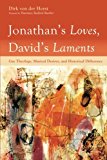 Music based on the same-sex love between Biblical heroes David and Jonathan is explored in the 2017 interdisciplinary book “Jonathan’s Loves, David’s Laments: Gay Theology, Musical Desires, and Historical Difference” by Dirk von der Horst. He connects the writings of LGBTQ theologians and Bible scholars with early modern musical interpretations by composers such as Handel and Weelkes. Queer possibilities are reinforced when he listens closely to the music with scholarly exegesis and historical analysis of whether the love between Jonathan and David was homoerotic. It includes a foreword by pioneering feminist theologian Rosemary Radford Ruether. The author teaches religions at Mount St. Mary’s University, Los Angeles.
Music based on the same-sex love between Biblical heroes David and Jonathan is explored in the 2017 interdisciplinary book “Jonathan’s Loves, David’s Laments: Gay Theology, Musical Desires, and Historical Difference” by Dirk von der Horst. He connects the writings of LGBTQ theologians and Bible scholars with early modern musical interpretations by composers such as Handel and Weelkes. Queer possibilities are reinforced when he listens closely to the music with scholarly exegesis and historical analysis of whether the love between Jonathan and David was homoerotic. It includes a foreword by pioneering feminist theologian Rosemary Radford Ruether. The author teaches religions at Mount St. Mary’s University, Los Angeles.
David and Jonathan prayer
Q Spirit’s Litany of Queer Saints includes this line:
David and Jonathan, heroes of the Hebrew scriptures whose souls were knit together, who pledged their love for each other with kisses, tears and covenants, pray for us.
LGBTQ books related to David and Jonathan
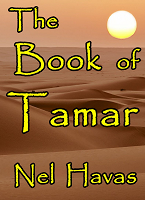 It becomes clear that David and Jonathan were lovers in the well-researched historical novel “The Book of Tamar: Daughter of King David” by Nel Havas. As seen through the eyes of a young woman who is his daughter, David “is attracted to anyone beautiful, whether woman or man” and “Jonathan was the love of his life.” The love between David and Jonathan is revealed as part of a larger Biblical drama of rape, incest, murder and war, with Tamar as the unwilling catalyst to cruel events. Hana, her strong and sensible servant, disguises herself as a male warrior to protect Tamar. Their relationship grows as they make a remarkable journey to find David in an effort to prevent family drama from degenerating into civil war. The author has also written two historical novels set in ancient Egypt, “The Apprentice Queen” and “Sekma.”
It becomes clear that David and Jonathan were lovers in the well-researched historical novel “The Book of Tamar: Daughter of King David” by Nel Havas. As seen through the eyes of a young woman who is his daughter, David “is attracted to anyone beautiful, whether woman or man” and “Jonathan was the love of his life.” The love between David and Jonathan is revealed as part of a larger Biblical drama of rape, incest, murder and war, with Tamar as the unwilling catalyst to cruel events. Hana, her strong and sensible servant, disguises herself as a male warrior to protect Tamar. Their relationship grows as they make a remarkable journey to find David in an effort to prevent family drama from degenerating into civil war. The author has also written two historical novels set in ancient Egypt, “The Apprentice Queen” and “Sekma.”
“The Love of David and Jonathan: Ideology, Text, Reception” by James E. Harding (2014)
“Jonathan Loved David: Homosexuality in Biblical Times” by Tom M. Horner (1978)
“The Prince’s Psalm” by Eric Shaw Quinn (2016) (historical novel about the homosexual love between Jonathan and David)
“Jonathan’s Loves, David’s Laments: Gay Theology, Musical Desires, and Historical Difference” by Dirk von der Horst (2017)
LGBTQ links related to David and Jonathan
“Homosexuality and the Bible: Studies on Jonathan and David” by Bruce L. Gerig (The Epistle)
David and Jonathan: Why did God focus on their intimate partnership? (GayChristian101)
David the Prophet and Jonathan, His Lover (Queer Saints and Martyrs – And Others)
“Jonathan & David: David’s Lament: Homosexuality and the Bible, Key Passages: 1 Samuel 31, 2 Samuel 1” by Bruce L. Gerig (epistle.us)
“Jonathan” by Anthony Oliveira (queerbible.com)
“David and Jonathan” by 17th-century Dutch artist Ferdinand Bol at Israel Museum
Bible story of David and Jonathan’s first meeting: 1 Samuel 18
Bible story of Jonathan’s death: 2 Samuel 1
To read this article in Spanish, go to:
David y Jonatán: El amor entre hombres en la Biblia (Santos Queer)
___
תפילת משיח קשת בענן (Rainbow Christ Prayer in Hebrew from Q Spirit)
___
Top image credit: David and Jonathan window (detail) from St. Mark’s Portobello, Edinburgh, Scotland, 1882. Special thanks to Ruth Innes for the photo and info.
________
This post is part of the LGBTQ Saints series by Kittredge Cherry. Traditional and alternative saints, people in the Bible, LGBTQ martyrs, authors, theologians, religious leaders, artists, deities and other figures of special interest to lesbian, gay, bisexual and transgender and queer (LGBTQ) people and our allies are covered.
This article has evolved and expanded greatly since the first version was posted in December 2009. It was published on Q Spirit in December 2016, was expanded with new material over time, and was most recently updated on Dec. 29, 2024.
Copyright © Kittredge Cherry. All rights reserved.
Qspirit.net presents the Jesus in Love Blog on LGBTQ spirituality.

























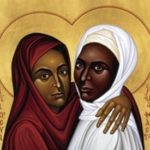
Wonderful article.
Plus my gratitude for mentioning our upcoming theatre production ID-DNUB TAL-MAGHZULIN (Sin of the Chosen) on the subject.
A number of respondents above make incorrect assertions about the words used in the passages about David and Jonathan. In particular, several state that the Hebrew word for “love” (ahab) does not include sexual overtones. Recourse to any good Biblical Hebrew lexicon will show immediately that this is incorrect. The root and its various forms cover almost exactly the same range as the English word (and its various forms) “love” including everything from marital love to friendship and even illicit carnal relations. (The latter in the piel form, mostly in the prophets condemning Israel’s adultery; e.g., Ezek 23.5)
The same goes for the Greek, although the root word used for Jonathan’s love for David is not PHILEO but AGAPEO. (See 1 Sam 20:7) This word is also that used for the love of husband and wife.
Those who are merely ignorant of this fact should educate themselves before they speak; those who know it but choose to misrepresent the truth are bearing false witness to Scripture itself.
None of this answers the question of exactly what the “love of Jonathan for David” was, except that the text marks it as clearly unusual, if not unique, and it was recognized as such in the tradition.
Thanks, Tobias, for enlightening us by sharing your education-based knowledge of the linguistic sexual meanings in the Biblical account of Jonathan and David — as well as sharing your artwork here.
As noted in the article, this piece is the all-time most popular post here at Q Spirit. That means it also generates lots of comments, including some ignorant ones. I approve those as well (IF they are on topic and not repetitive) out of fairness and so that readers can see that it is still controversial to say that the Bible affirms LGBTQ people.
Which biblical verse indicates that David or Jonathan was bisexual ?
The most commonly quoted verse about this is David’s lament over Jonathan when he says, “Your love to me was wonderful, surpassing the love of women” (2 Samuel 1:26). Please read my whole blog article for more details.
Thank you for this! I am a Gay man and god loves me. Bless
At the end of the day, the bible was interpreted by a gay man king James, so hey, live well and love your life. Amen.
I am a gay man as well. We all should read the following passages from the Old Testament 1 Samuel 18:1-4, 1 Samuel 19, & 20, 1 Samuel 20: 41-42, 2 Samuel 1:23 and 2 Samuel 1:26
God’s love is all inclusive…..very interesting article….am a married gay man (widowed twice actually) and very happy with husband #3 for two years now. The Bishop officiated at our wedding. Thanks for all the information, I had not known this.
All through the Bible the word Love is never used to indicate sex. It is always “knew, know, or known her” including a rape. Like in Sodom when the men sought “to know” the angels that came to Lot but he offered his daughter instead. Its deceitful to your own soul to think David was a man “after God’s own heart” and king of a people that shunned Sodomy, but would still have a sexual relationship with a man. The covenant between them was a pact or deal not a marriage. Its also destructive to the soul to pervert the Bible. God loves all people and came to seek and save that which is lost. It’s not the actions of a man that condemns him but our sin nature. A bear kills because its his nature. You can’t train it out of them. It can be suppressed but it’s there. To change his nature it would take a supernatural force. To make him completely harmless he would need to have the bear nature removed. Same with man. We have a nature that’s “as filthy rags” when compared to God’s holy nature. I pray that whoever reads this soon has their heart stirred by the Word of God and is lead to salvation thru the blood of Jesus.
Since David was only 15 when he slew Goliath, Jonathan is much older and there is zero evidence for what would have been a completely inappropriate (and currently illegal) sexual interaction, as there is zero evidence for any erotic interaction between Ruth and Naomi, attempts to infuse the initial interaction with more than a starstruck Jonathan when faced with the Godly and heroic David are reading inappropriate implications into the text which are not there, as stated multiple times above.
Once again, the original language doesn’t imply what you’re claiming here: the fact that “love” in modern English usually implies romance does not mean that the original Hebrew in these passages implies the same thing; and kissing was the common form of greeting in that society (as it still is in many Middle Eastern societies even today), so you’re taking that out of context as well. And as others have noted in the comments, if a man says that his bond with another soldier is deeper than his love for women that usually means that it’s also a completely different type of bond – i.e. not romantic or sexual at all – since it’s the bond that develops due to risking one’s life for a fellow soldier in battle. It’s possible to be more attached to a fellow soldier than to one’s own wife, but also to not have the slightest romantic feelings for the soldier in question. You also claimed that the covenant between David and Jonathan is a “same-sex wedding vow” which is nonsense: it doesn’t describe a marriage.
I was in the military. Andy friendship with brother is special. Wives n gfs come and go but friendship lst forever. Love should not b equated to sex. Be with whoever arouses you but stop twisting facts.
Excellent article. However, as many are now aware, people in the ancient world were not labeled to indicate the sex of their bed partners. Therefore the use of the terms gay and bisexual in reference to David and Jonathan is anachronistic. As I make clear in my book, the Origins and Role of Same-Sex Relations in Human Societies, the sexuality of people in the ancient world should be described as ambisexual, a term favored by the late Vern Bullough who defined it in his book, Human Sexuality: An Encyclopedia, as the ability to eroticize members of both sexes under varying circumstances. It was generally recognized in the ancient world that all people were susceptible to same-sex desire, though it was also understood that preferences for one sex or the other varied among people.
A minor note: I don’t think young David would have had a beard, as is shown in some of the illustrations on this page. In the ancient Mediterranean world the younger lovers of adult males were nearly always depicted as beardless.
Also, the LGBTQ links should include links to the superb articles by the late Bruce Gerig, on the Epistle.us. His articles feature extensive analysis of the scriptural text from 1 and 2 Samuel, including citations to the work of other scholars. Gerig also has illuminating articles on Epistle.us on the relationship between Jesus and the Apostle John, the story of Sodom, the writings of Paul on sex, as well as on the various scriptural passages purporting to condemn same-sex sexuality.
Thank you for your informative, educated comment. I went ahead and added a link to Bruce Gerig’s article on “Jonathan & David: David’s Lament: Homosexuality and the Bible.” I look forward to exploring more of his work and adding links where appropriate to his articles on the relationship between Jesus and the Apostle John, Paul’s writing on sex, etc.
I also appreciate the reminder about your own groundbreaking book, “The Origins and Role of Same-Sex Relations in Human Societies.”
I do not know if David and Johnathan ever consummated there love relationship?! But I know they loved each other better than the opposite sex and loved each other better than life!! Their souls were one even if they never made love they were true soulmates!
Special bonds grow between people. These bonds do not equate with sexuality. Sadly, men tend not to share their feelings for fear of being labeled as gay; but men can share a bond which other may not understand or grasp. Military personnel and police often share a bond that transcends basic friendship; these bonds (to those not knowing the depth of their kinship) may think its homosexual – but it’s far from it. You would die for this person – and they would for you. You are born into a family; but you choose your friends.
The closest bond for me to compare would be father to daughter, father to son. They both have deep embraces, love, sacrifice, willingness to give all — but there is no sexuality.
It’s a special bond that only those who have it can understand my ramblings.
Theres a lot wrong about this article, but for starters it mentions there were no wedding ceremonies in the bible, when Jesus’ first miracle was water into wine at a wedding ceremony. It’s dangerous to squeeze scripture dry with our own interpretations and there are a lot of contextual issues about the alleged “proof” of Jonathan and David’s relationship being romantic/sexual. This article is riddled with assumptions with no real knowledge of the original text and it’s etymology. There is a lot of important nuance in words like “love” when you study the greek/Hebrew text. and the way love was used has a diplomatic nuance/specification towards Jonathan. Read your bibles folks and let the Holy Spirit lead you into understanding…
What I meant was that there are no scripts to use at wedding ceremonies in the Bible. I added that phrase to my article to clarify it. Of course weddings are mentioned in the Bible. It just doesn’t say what words were spoken by the participants.
Absolutely beautiful article. Amazingly articulated and very well researched. Thank you for sharing this important historical and philosophical information. You are truly making the world a better place. Much respect to you!
Guys can have friends XD judgemental heretics
What we need to do is look at these passages to observe whether they really condemn homosexual behavior between two consenting, free adults, or whether some other form of activity is being described. God bless us all!
This is how cults and all this foolishness is made. You take words out of context and you can make it what ever you want it to be. A curse is coming on those who lead Gods little ones astray Matthew 18:6. God makes it clear that homosexuality is a sin, and if David and Jonathan where in a homosexual relationship (they were friends) then God wouldn’t have allowed that. It is ok for another man to show love for another man but God is against homosexuality. 1 Corinthians 6:9
Jesus Christ, who is GOD INCARNATE, never said one word about gays, never condemned them, but He did tell us to NOT JUDGE ONE ANOTHER BUT LET GOD BE THE JUDGE. He did condemn divorce, hypocrisy, greed and other things. So your comment is BUNK.
These aren’t my own words but they are perfect in reference to this ignorant articleJonathan, King Saul’s own son and warrior prince of Israel, seems the most likely and right choice to assume the throne of Israel after his father. But Jonathan is aware at the time of their meeting that David is God’s choice to be king. Jonathan’s response is not one of suspicion but of spiritual unity. He heard David recount God’s power to slay the giant Goliath. Upon David’s testimony of this battle, Jonathan’s spirit was attached (”knit“) to David’s in alliance, and they felt they were one – spiritual brothers under the heavenly King.
Such selflessness and spiritual friendship is impossible apart from God’s irrevocably changing a heart. Homosexuality is not about the selfless love on display in David and Jonathan, but is at its core a lust concerned with worshiping the form of someone who mirrors yourself in body and form.
David and Jonathan show us that redeemed men don’t need sex to relate to one another. Apart from laying down our prizes and armaments before God’s choice King, not one of us can ever hold fast to what is good, nor love each other with brotherly affection and outdo one another in honor (Rom. 12:9-10). It is the common bond of Jesus Christ that can alone lead men to genuine love.
Read on in 1 Samuel to see the truth behind David and Jonathan and how their relationship played out. They had an honorable, intimate and God-revering friendship centered not on themselves but on the God who keeps covenant with those who love Him and keep His commands.
If homoerotic overtones are to be the new norm applied to male friendships and affection in this young century, we men of God need the godly truth about David and Jonathan to stand in stark contrast against a sexually misguided and increasingly corrupted cultural view of male relationships.
Kimberly,
You use words of harmful intent such as lust, corrupted, ignorant and misguided and should apply them to yourself. How dare you pretend to know another and twist their sacred love into lust. Judgmental fundamentalists make the grave errors of arrogance and assumption , implying that they alone know what is in the mind, soul and emotion of another. They start with a misconception or lie and work their way backwards, cherry-picking the Old Testament to fulfill their bias. They ignore love and focus obsessively on sex, sex, sex, because love destroys their arguments and protestations. To go forth and multiply was the focus in ancient Biblical times. Your one quote, Thou shalt not lay down with a man as with a woman refers to this. You could have as many wives as you could afford and kill your own children if they were disobedient, among many other permissions considered intolerable and immoral today. There are reasons that the OLD Testament is referred to as such. The NEW Testament has no references to same gender love, and The Son of God, Jesus Christ, made no mention nor condennation of homosexuality. Beware when you attack God’s children and fail the tests of love, compassion and discernment. Love is the greatest of all of these.
I can see how you might think that the relationship is of that nature but unfortunately the Hebrew word for love is not intended to be of a sexual relationship but one of spiritual and friendship. I’m a lover of all (bisexual) and back then if He allowed same sex relationships we probably wouldn’t be here today.
Wicked, wicked, that you take Scriptures and twist them to suit yourself. Not once did God bless a same sex union in the bible. Not once. You do not understand the spiritual side of nature of love between true brethren. You sexualize that which is Holy and make it unHoly. There was NO sex between David and Jonathon. NONE. Scripture is showing the TRUE Godly love (with no sex!) between 2 of people of God. Shame on you. No LBGT will go to Heaven. In other words, the lifestyle will NOT be practiced in Heaven. Read Romans 1 in its entirety to see how that and other lifestyles will not be practiced. God does NOT bless that which He is VERY specific against.
“Open my eyes that I may see, visions of truth, thou hast for me, open my heart illumine me, Spirit Divine”. Open your eyes and smell the coffee, your prejudice and preconceived notions of what you think life should be are showing through. Get real and reread the story of David and Jonathan with blinders off.
God says love thy neighbor. You should do the same. Amen.
It looks like your argument hinges entirely on artists’ interpretation of a very select few verses.
You’d have to ignore the whole of the bible to conclude that David was a homosexual and still “a man after God’s own heart.
Of course David sinned, but when he did, God was displeased, and David crumbled internally. When he confessed, he was restored to God and forgiven–yet not without consequence for his heinous actions. You can’t conclude that God approves of something he condemns multiple times elsewhere.
You’re interpreting the “kiss” scripture with modern and western eyes, not to mention stretching it to fit your own narrative. Kissing isn’t always indicative of a sexual relationship. In ancient cultures or in some modern cultures across the world.
Correct, but I’m personally hinging it on the part where David literally said Jonathan’s love was “more wondrous than a woman’s love.” So two kissing men who cite each other’s love as beyond a woman’s love is what I call two gay dudes, no matter how much you want to hetwash it. Given that the exact same culture where these two men are kissing each other would go on to put two men to death for kissing because it was presumed homosexual beyond all denial, I’m goin’ with gay.
David could Not have defeated Golith the pilistine giant has he been out of favor in the Eyes of the Lord. Nor would have defeated 10 thousands of emenys in battle
Or even become king of Israel . Yes he did sin once king sending a man into the battle front to get killed so he could take his wife sexually.and looked upon Bathsheba while bathing in lust of her. And had several sexual affairs with women. But upon his return ancestry to God his heart pure before the Lord was the apple of God’s eyes. Had David had a s homosexual relationahip with Johnathon he wouldn’t have become a great king and favor of God yes he loves Johnathon and kissed Him this was customary of the time in greeting a dear friend. Some so called scholars have turned the scriptures into their personal agenda for LBGTQ community to say you too can remain homosexual and God is ok with it. It’s a total deception of anti Christ proportions false teaching of scripture. Tom Horner, Bible scholar and Episcopal priest has twisted scripture of this,saying King David had homosexual feelings of Johnathon a Lie of Satan. I am greived in my spirit of such false teaching and spread this lie. Twisting scripture is damming of one soul and remember the word of God I’d God Himself that speaks of him his character it breaths and lives. Becareful my friends
people condemning other people to hell must stop and think again. what if you are wrong and must stand in front of God and explain of the millions of gays that have commited suicide because of the internal struggle they had to be a follower of Jesus and be homosexual. look at what is written about homosexuality with an open mind and remember that God is not seeing things as we see them. `what everyone knows is that as you judge, you will be judged.
As Saul continues to pursue David, the pair renews their covenant, after which they do not meet again. Eventually Saul and David are reconciled. Jonathan, however, is slain on Mt. Gilboa along with his two brothers Abinadab and Malchi-shua, and there Saul commits suicide.
I really hope my comment make it about how the word using to describe Jonathan & David’s love is PHILIO – frienship not EROS – Lust. So pleaseeee writer of this blog i believe you really want to find truth right & have friend who support you to walk in the right terack, not just finding the desire of the flesh, and words to make one heart happy but without truth. 🙁 let other decide please . Much RESPECT.
DO NOT GO ASHTRAY!
IN THE REAL SCRIPTURE: USING HEBREW, DAVID & JONATHAN LOVE WAS DESCRIBED WITH THE WORD PHILIO MEANS FIENDSHIP LOVE!!!!! NOT EROS – LUST. GOD WORDS ARE TRUTH AND NOT JUST MEANT TO MAKE YOU HAPPY & GET WHAT YOU DESIRE. DON’T PLAY WITH GOD WORDS! BLESS U & I LOVE ALL PEOPLE BUT YOU CANNOT TWIST GOD WORDS.
You wrote, “Do not go ashtray!” Does that mean you want us to stop smoking? Your spelling mistake makes me laugh. I don’t smoke or have any ashtrays.
I know you meant, “Don’t go astray!” But how can I believe your message when you are so careless with your words? As you wrote, “DON’T PLAY WITH GOD WORDS!”
The last time I looked, eros and philio are Greek words. In Hebrew, the word is ahav, and that carries a wide range of connotations. In 1 Sam 18:1, Jonathan “loves” David and in 18:20, Michal “loves” David. Exactly the same word is used. Any translation of these two verses should reflect that the same verb is used.
The idea that Jesus said nothing about homosexuality in the scripture is false. Jesus Christ was the God/man or God come in human flesh. As God he spoke to the homosexual issue condemning it in Leviticus and Romans through the apostle Paul. As God all comments condemning homosexuality in scripture are attributed to the Father, Son and Holy Spirit equally. They are in total agreement on everything forever and will never change. Therefore all the attempts to subvert the teaching of scripture on homosexuality and lesbianism as sin as well as all other forms of sex besides heterosexual sex within the context of marriage are futile and seek only to excuse those who love their sexual preference more than the word of God and obedience to that word.
Stop trying so hard to find human resources that verify your sinful behavior as favorable and consistent with God’s desire for man. It will not work out in this life or on the day of judgment. The time to repent of this behavior is today. None of us are promised tomorrow.
Here is an article on David and Jonathan that will help.
https://hipandthigh.wordpress.com/2014/02/28/were-david-and-jonathan-gay-lovers/
Some believe that Jesus spoke to affirm LGBTQ people when he said, “For there are eunuchs who were born that way, and there are eunuchs who have been made eunuchs by others–and there are those who choose to live like eunuchs for the sake of the kingdom of heaven. The one who can accept this should accept it.” (Matthew 19:12). “Eunuch” is an ancient term for people that are called LGBTQ today.
“that will help”
The hubris here!
You say yourself, that none of them are Jesus’ words. They are from the laws of Leviticus and writings of Paul. Jesus did not discriminate in his description of love. Most of the time he was not referring to Eros but philios, however, he did not deny any love, it is others that did. Why the hang up on a romantic love that comes natural to some people?.To me a physical heterosexual love feels very unnatural but it does not force me to condemn it To me a homo sexual love surprises me no than it did Jesus. And No more than it does God today. I am convinced without doubt that God loves me no less than he does you or anyone. I am not hurting any one nor taking advantage of anyone in my monogamous consensual relationship. My love is no less authentic or perverted than any heterosexual love. It just happens to be between two humans that are both men. Our love is as truthful and as secure as the bond between people of opposite sex. We’ve been together and faithful and loving to each other for 32 years, far more than many hetero relationships. No one gives you the right to degrade, mock or call the relationship between my husband and I any less worthy than that of your own, unless you wish to be called a hypocrite or blind to the fallacy of many “straight” marriages. God’s love is not selective but universal and unconditional. God’s love is for all, for we are all sinners and Christ died for us all.
This comment is to @Kittredge Cherry. If Jesus was affirming homosexuals, then why did Jesus say that a man should cleave to his wife when he leaves his family? Not only that, but if you believe Jesus is God, and Jesus said “Before Abraham was, I am” that means God is the same God of the Old Testament. If God is the God of Truth, and he is the same yesterday today and forever, what he meant back then is the same for now. Nothing is new under the sun, and homosexuality has been practiced for many many years.
Hi 🙂
I have just one small question. Do you know the painting with the same topics that was to be seen in the Israel Museum in Jerusalem? I did see it there in 1998 and they also had a poster for selling with it. It was from an older artist, his name I did forget. The title was like Jonathan recognizes David. I often tried to find it in the internet but could not.
If anybody has a tip then please send me an email.
Thank you very much
Ernst, I did some searching and found “David and Jonathan” by Ferdinand Bol. It is a beautiful painting by a 17th-century Dutch artist at the Israel Museum. Is this the painting you mean? You can see it at this link:
https://www.imj.org.il/en/collections/375853
I will also link to it in my main article. Please let me know if this is the right painting.
@Kittredge Cherry Eunichs were men used as guards To guard women and children in the living quarters. They were essentially soldiers who had their junk cut off, emasculated to take away their sexual desires and abilities. This made them immune to the urges of ordinary men. They weren’t LGBTQ, born gay…or whatever you’re trying to bend the scriptures to fit your narrative.
Eunuchs are men who have had their testicles removed in order to make them more efficient servants or soldiers, as they are not distracted by lust or sexual matters.
I believe David and Jonathon were in a homosexual relationship. Homosexuality is indeed part of world history! In fact, I believe there were many men in ancient times who were in fact gay. Plato was thought to be gay! That’s one right off the bat I can think of.
Concerning David and Jonathon, it was not just brotherly love. The depth and emotions of their feelings for one another are very recognizable to me. I, myself being a gay man can connect to their compassion and feelings for one another. It was art! Dramatic! Hidden and it’s as if they were somewhat ashamed around their families. They were indeed gay! Feelings such as these are NOT bromance! It’s a story of two men who loved one another. It is what it is.
David said to Jonathan: “Your love to me was wonderful, surpassing the love of women’.
Edgar Cayce gave a status to Jonathan that He was “Twin Soul” of David. Further, Mary was the “Twin Soul” of Jesus.
Thank you for this. As a heterosexual Christian I can appreciate an article that supports the LGBT community. They are shunned, condemned, judged, ostracized and otherwise subjected to sundry other anti-Christian abuses by the majority of Christians. I quote Gandhi whos life mission has often been compared to that of Jesus Christs “There would be more Christians if it weren’t for Christians’ Fellow Christians, we are called to Love. Anti-LGBT is Fear based and not in alignment with the Christian religion.
There is no justification for homosexuality or lesbianism or any other sexual act outside of heterosexual sex and that only in the context of marriage.
You say; “While the Bible doesn’t explicitly state that David and Jonathan were lovers, Jesus himself did not say anything directly about homosexuality in the Bible either. Scripture does not condemn loving, responsible homosexual relationships.”
1. The Bible doesn’t even insinuate that David and Jonathan were lovers. If you objectively examine scripture concerning scripture without homosexual or lesbian bias coloring your examination you will know that the Bible condemns all sex outside of the context of marriage between one man and one woman.
2. Jesus definitely did say something about homosexuality and all other sex outside marriage and he only honored heterosexual marriage as established in Genesis 2:4 where the words man and wife are spoken of. Christians believe that Jesus Christ is the God/man or the fusion of two natures, divine and human which in theological terms is called “the hypostatic union.” Since the Godhead consists of the Father, Son and Holy Spirit who never differ in anything they all agree on the pronouncements found in Leviticus and in the book of Romans concerning the issue of homosexuality and lesbianism and all other sexual activity outside of heterosexual marriage. Here are the words used to describe sex outside hetero marriage; abomination, burning in lust, vile affections, that which is against nature and etc. Not flattering in any sense to those who are honest with themselves and others.
3.While all sexual activity outside of heterosexual marriage is called sin and condemned by God mankind was destined for eternal damnation apart from the intervention of a loving God who was not willing that any should perish but that all WOULD COME TO REPENTANCE. (2 Peter 3:9)
4. God provided the solution for all mankind who would repent. He sent his ONLY BEGOTTEN SON. He sent what was most precious to him to die in the place of all who would humble themselves, confess their sin and repent with all their heart and seek his forgiveness. Revelation speaks of those people as being written in the Book of Life. Revelation 20:10-15 Those who are written in that book, and only those are granted eternal life in the loving presence of a Holy God. All others are cast into the lake of fire spoken of in these verses.
You must make a decision. Either God is telling the truth on everything and his word is indisputable or you must refute the Bible and die without Christ and without hope of redemption. There is no excuse that can be offered when we all stand before God’s throne on the day of Judgment spoken of in these verses. We will either stand forgiven or condemned. There are no options. What will you do. Your eternal destiny hangs on your answer.
Lee;
I believe your understanding of the word Christian and your lack of a clear understanding of Christians who study and obey the scriptures has led you to serious error as your comment proves.
What you call anti-Christian abuses are not a genuine picture of Christians who love, honor and obey the Lord Jesus Christ. Christians are like David the king of Israel. They “hate every false way” as he did. They do not invalidate the value of people no matter what sin they are guilty of because Christians know that “All have sinned and fall short of the glory of God.” Romans 3:23
Ghandi and other non-Christian, religious pacifists are often quoted by those whose picture of genuine Christians is distorted as yours is. All Christians who truly love and obey Jesus Christ love everyone and want what is best for everyone but they are not given the freedom to legitimize sin or condone it any more than God himself would.
Your “fear based assumption” concerning those who rebut the sin of sex that is outside heterosexual marriage is totally without merit. Perhaps you have Christians and Catholics confused. Many people believe they are synonymous but they are worlds apart. One is a religion based on works and the other is a “relationship” based on love for Jesus Christ and obedience to him in everything. The relationship with Christ is what constitutes true Christian belief and the tenets such people adhere to and that are fully biblical. Christians fear nothing except God himself and their service to him is an admixture of fear and love; not one or the other. Fear of damnation is real for all believers but God’s love being returned to him for his generous gift of salvation is equally real. Both his love and wrath are perfect.
The Bible says there is no fear in love. Christians love the people who live in sin but do not condone their sin. They believe God calls them to warn people to flee the wrath of God by running to the arms of Jesus for salvation and eternal life. You entire premise is denied by this love.
I am a woman who loves a woman, and I am also a Christian who has read the Bible through several times, especially focused on the story of David and Jonathan. It does not hint at all that there was a sexual relationship between the two of them. It indicates that there’s a form of love HIGHER and more beautiful and more perfect than the love between sexual partners. Most of the LGBTQIA+ community does not understand this. Scripture clearly condemns homosexual activity in both the old and new testament of the Bible, but it has plenty to guide people who are not sexually attracted to the opposite gender on how to love each other appropriately in a way that would not be sinful. If there will be sexual activity between people of the same gender, they must turn their backs on God and on the truth to do so and live their lives according to their own will, not trying to manipulate the word of God to condone their lifestyles or to prove to Christians that they are right. If someone in the LGBT+ community does believe in God and wants to do the right thing, that person can sincerely pray and search scripture with an open heart to God’s will and that person will be lead in the right way.
While the Bible doesn’t explicitly state that David and Jonathan were lovers, Jesus himself did not say anything directly about homosexuality in the Bible either. Scripture does not condemn loving, responsible homosexual relationships. There are many resources that fully explain the Bible and homosexuality. Here are a few that I recommend
The Bible and Gays: Is it a sin to be gay? Did Jesus condemn homosexuality? http://jesusinlove.blogspot.com/2013/10/the-bible-and-gays-is-it-sin-to-be-gay.html
http://mccchurch.org/resources/mcc-theologies/
“What the Bible Really Says about Homosexuality” by Daniel Helminiak
http://www.visionsofdaniel.net/bookWBRS.htm
http://christiangays.com/
http://www.gaychurch.org/